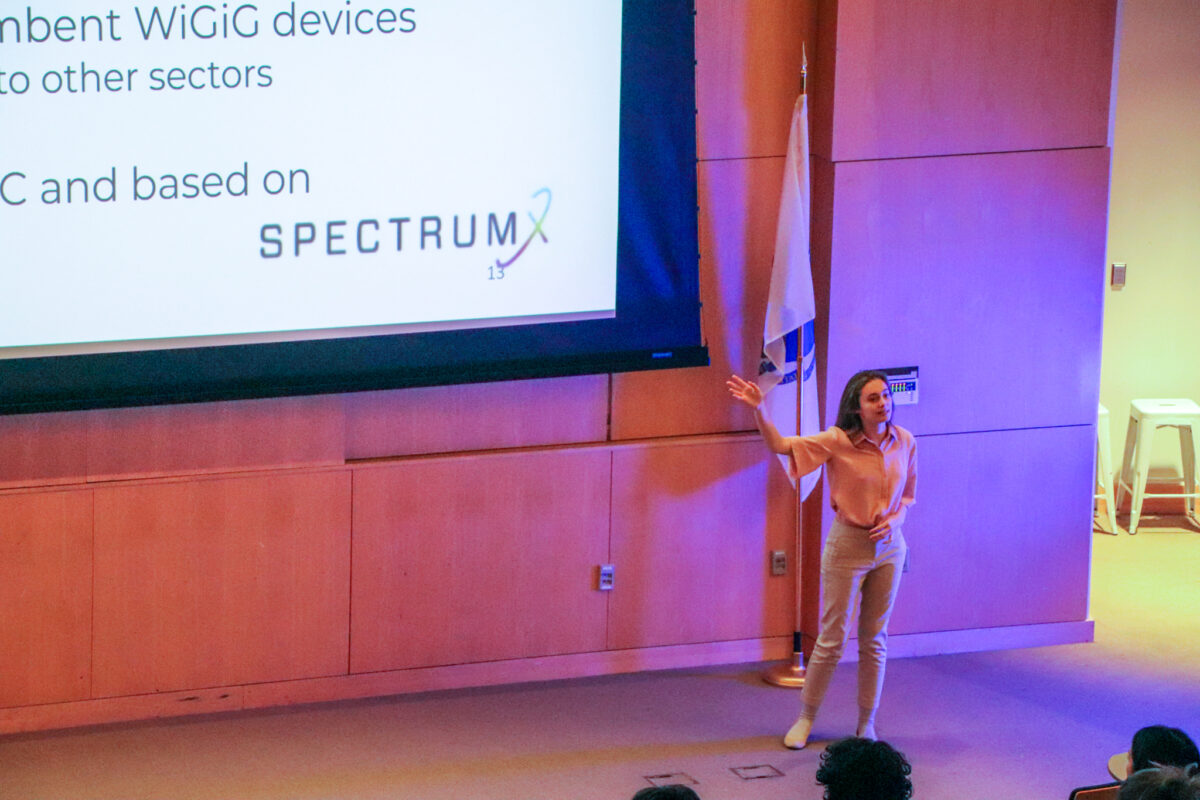Research and interaction with SpectrumX experts ignites students passion for radio spectrum coexistence issues

By Christina Clark
Photography and Videography by Angie Hubert, Notre Dame Research
Throughout the Fall of 2022, assistant professor of engineering Whitney Lohmeyer guided undergraduate students through her Introduction to Analog and Digital Communication course at Olin College of Engineering, connecting them to radio spectrum experts.
Lohmeyer is the Director of the Olin Satellite + Spectrum Technology & Policy (OSSTP) Group and Use Cases and Coexistence Research Working Group Lead for SpectrumX – a National Science Foundation Spectrum Innovation Center. Her students benefited from speaking with SpectrumX’s experts across the country, as it allowed the students to incorporate feedback from first hand experience to deepen their research for their final projects on spectrum coexistence challenges.
“Some students never come in contact with research. Maybe they find it intimidating to join a lab, or they don’t have confidence their skillset,” Lohmeyer said. “By bringing research into the classroom, you give all students a structured opportunity to engage.”
As she was preparing her course, Lohmeyer was able to transfer the knowledge she gained from the SpectrumX Research Working Group that she leads. She and her colleagues identified 12 different coexistence issues that have arisen among stakeholders, including those who work in radio astronomy and large non-geostationary (NGSO) constellations, and those who use the spectrum bands with radar altimeters and 5G technologies. She assigned a group of students to each of the 12 coexistence issues and used her connections within SpectrumX to support their research efforts.
For the class’s midterm presentation, Lohmeyer arranged for the students to present to members of SpectrumX. The members were invited not just to listen but also give constructive feedback to the students. These presentations and connections were made during the October 2022 Spectrum Center Meeting.
Stakeholders and researchers at the meeting continued to engage with students after their presentations. “Students got to meet folks who had dedicated their life to some of these applications, developing hardware, launching satellites in the bands, and more,” Lohmeyer said.
“It was interesting learning from different perspectives how [stakeholders] approach sharing bandwidth, and the different things that are involved,” said Andrew Mascillaro, a student at Olin majoring in electrical and computer engineering. “I have a greater appreciation for the complex mechanics that go into sharing spectrum with all the parties that are involved.”
Bernard Adjei-Frimpong, a postdoctoral researcher at Olin College and member of OSSTP, said connecting with experts in the field was a valuable opportunity for everyone involved.
“It has been an amazing experience. My area of study was radio wave propagation in the millimeter wave bands, so when I saw that the students were doing research on interference analysis, it was an opportunity for me,” Adjei-Frimpong said. “This is an area I want to go into and further develop my career.”
The course inspired several students to continue their research on the radio spectrum.
“Being able to do this as an undergraduate was a really exciting opportunity. At first, it was a little daunting because I hadn’t really been exposed to the material,” said Caitlin Coffey, a senior at Olin with an area of focus on cybersecurity. “Over time, through the class, it felt really natural to be able to look at different research papers and interview different people that were in the field. We learned a lot more about what they do, and also what kind of research is out there.”
At the end of the course, many of the students’ final projects will be made available to the public so they can help others learn more about coexistence challenges in the radio spectrum. The video series will debut on the SpectrumX website and YouTube channels, and it will be accessible for those looking for an introduction to the topic.
About SpectrumX
SpectrumX is funded by the National Science Foundation (NSF) as part of its Spectrum Innovation Initiative, under grant number AST 21-32700. SpectrumX is the world’s largest academic hub where all radio spectrum stakeholders can innovate, collaborate, and contribute to maximizing social welfare of this precious resource.
To learn more about SpectrumX, please visit spectrumx.org.
Contact:
Christina Clark, Research Communications Specialist
SpectrumX / Notre Dame Research / University of Notre Dame
cclark26@nd.edu / 574.631.2665
spectrumx.org